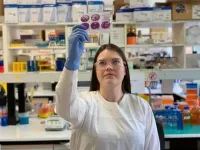(Press-News.org) Because cancers in children are rare, many details about their biology remain unknown. In the field of cancer genetics, there's a limited understanding of how inherited genetic changes may contribute to the formation and growth of tumors. Making connections between particular gene mutations and disease requires a lot of data, which until recently has been largely unavailable for pediatric cancers.
Now, tests like MSK-IMPACTTM can screen tumors for mutations in more than 500 genes as well as analyze patients' normal (germline) cells. In the largest study of its kind so far, researchers from Memorial Sloan Kettering's pediatric program, MSK Kids, are reporting germline genomic sequencing details for 751 pediatric patients treated for solid tumors.
The paper, published February 15, 2021, in Nature Cancer, explains how understanding the hereditary factors associated with children's cancers can help both patients and their family members better understand the risk of future cancers. Armed with this information, they can undergo screening and prevention measures as appropriate. It may also be used for family planning purposes. In a small but growing number of cases, this information may even help select the most appropriate treatment for a child's cancer.
"Many of the associations we are learning about with this kind of testing were not previously known and have broadened our understanding of how inherited genes may be related to a predisposition to pediatric cancers," says genetic counselor Elise Fiala, the paper's first author. "We're hoping to raise awareness about these connections and about how testing for these inherited genes might be clinically useful."
Updating Guidelines for Genetic Screening
For certain types of adult cancers -- such as breast cancers and colorectal cancers diagnosed in younger adults -- the importance of screening patients for mutations in the BRCA1 and BRCA2 genes and Lynch syndrome is well established, especially for people who may have a family history of many cancers. But hereditary links to pediatric cancers have been largely unrecognized. Additionally, guidelines for which pediatric patients should be screened for inherited mutations are based on limited data.
"This study shows that the criteria we currently use to determine who should receive germline testing are flawed," says physician-scientist Michael Walsh, the paper's senior author, who leads research on inherited pediatric cancer genomics within MSK's Robert and Kate Niehaus Center for Inherited Cancer Genomics.
"In about half of the patients in whom we found an inherited predisposition, we would not have predicted detection of a cancer predisposition mutation and would not have screened them," he adds. These findings included mutations in the BRCA genes; the genes associated with Lynch syndrome; the gene TP53, which is linked to an inherited disorder called Li-Fraumeni syndrome; and others.
The Value of Genetic Testing
There are many reasons why it's important to know whether a child's cancer is caused by an inherited gene mutation, which are outlined in the paper.
For one thing, it can guide treatment. For example, tumors caused by the genes associated with Lynch syndrome may potentially respond to immunotherapy drugs called checkpoint inhibitors. These drugs usually don't work in pediatric cancers, so unless a patient is known to have Lynch syndrome, they likely wouldn't be considered.
Learning that a child has an inherited cancer gene can also help families. Parents, siblings, and other relatives may benefit from genetic testing to look for the same gene mutation. If the results are positive, they can be monitored more closely for cancer or consider preventive measures. For families that are planning to have more children, in vitro fertilization and preimplantation diagnosis -- in which embryos are screened for harmful mutations before being put in the uterus -- can be considered.
Testing for germline mutations in pediatric cancers can also help researchers learn more about the causes of some of these cancers, which could lead to new methods of diagnosis and treatment. In the Nature Cancer paper, the researchers provide evidence of a previously unrecognized link between a gene called CDKN2A and osteosarcoma, the most common form of bone cancer in children and young adults.
Expanding Reach to Survivors of Childhood Cancer
The researchers report that only 31% of families with children found to have inherited mutations opted to seek genetic testing in additional relatives. Ms. Fiala says this was not surprising because these families were in the middle of coping with a child being treated for cancer.
"But these findings have much broader implications than for just the 16,000 children diagnosed with cancer in the United States every year," Dr. Walsh says.
Ms. Fiala explains that the results from the study are important not only for children currently being treated for cancer and their families, but for cancer survivors. "Many people who were treated for cancer as children are now at the age where they're considering having kids," she says. "We would love to see people who have a cancer history and are now planning families consider testing so they can learn more about their risks and options."
INFORMATION:
This work was funded in part by the Robert and Kate Niehaus Center for Inherited Cancer Genomics, the Pediatric Translational Medicine Program, the Marie-Josée and Henry R. Kravis Center for Molecular Oncology and the National Cancer Institute Cancer Center Core grant number P30-CA008748.
Astronomers have tested a method for reconstructing the state of the early Universe by applying it to 4000 simulated universes using the ATERUI II supercomputer at the National Astronomical Observatory of Japan (NAOJ). They found that together with new observations the method can set better constraints on inflation, one of the most enigmatic events in the history of the Universe. The method can shorten the observation time required to distinguish between various inflation theories.
Just after the Universe came into existence 13.8 billion years ago, it suddenly increased more than a trillion, trillion times in size, in less than a trillionth of a trillionth of a microsecond; but no one knows how or why. This sudden "inflation," is one of the ...
Human health and ecosystems could be affected by microbes including cyanobacteria and algae that hitch rides in clouds and enter soil, lakes, oceans and other environments when it rains, according to a Rutgers co-authored study.
"Some of the organisms we detected in clouds and rain are known to have possible impacts on human health and could also affect microbial populations at rainfall locations," said lead author Kevin Dillon, a doctoral student in the lab of co-author Donna E. Fennell, a professor who chairs the Department of Environmental Sciences in the School of Environmental and Biological Sciences at Rutgers University-New Brunswick. "More work is needed to confirm that and to ...
BETHESDA, Md. -- ASHP (American Society of Health-System Pharmacists) today announced the publication of two landmark reports that articulate a futuristic vision for pharmacy practice, including expanded roles for the pharmacy enterprise in healthcare organizations. The 2021 ASHP/ASHP Foundation Pharmacy Forecast Report and the Vizient Pharmacy Network High-Value Pharmacy Enterprise (HVPE) framework, published in AJHP, outline opportunities for pharmacy leaders to advance patient-centered care, population health, and the overall well-being of their organizations.
"During these unprecedented times, it is more important than ever for pharmacy leaders to demonstrate the value pharmacy services contribute ...
The short message service Twitter has played a prominent role in US politics in recent weeks and months and attracted a lot of attention. Even in business, Twitter users' tweets are being closely followed and used as a basis for decision-making. A new study shows that venture capitalists can also be influenced by Twitter sentiment when valuing start-up companies from the high-tech sector. "However, the sentiment signals on Twitter say nothing about the long-term investment success of such a start-up. Patent applications, for example, are much better suited for this," said Professor Andranik Tumasjan from Johannes Gutenberg ...
Since the 1980s, the physical and mental health of Swedish children and young people has been measured by way of surveys. One of these is the international "Health Behavior in School-aged Children Survey" (HBSC), which is taken by 11-, 13- and 15-year-olds every fourth year during a class in school.
Researchers Anette Wickström and Kristin Zeiler at Linköping University wanted to study the survey to see which norms can be conveyed in health surveys, something that has rarely been studied. The results have been published in the journal Children & Society.
"The study shows that survey questions on parents' occupation and financial situation create norms about how you should ...
A subtype of asthma in adults may cause higher susceptibility to influenza and could result in dangerous flu mutations.
University of Queensland-led animal studies have found that paucigranulocytic asthma (PGA) - a non-allergic form of the condition - allows the flu virus to flourish in greater numbers in sufferers.
UQ PhD candidate Ms Katina Hulme said this was due to the asthma's suppression of the immune system.
"We were first tipped off about this during the 2009 swine flu pandemic," Ms Hulme said.
"Asthma was identified as the most common underlying medical condition in ...
These observations might be useful for the future development of new antibacterial strategies. The team reports in the journal Applied and Environmental Microbiology on 12 February 2021.
Bacterial groups in search of food
We commonly know predator-prey relationships from the animal kingdom, but they are also a survival strategy of certain bacteria: bacterial predators actively kill bacteria of other species in order to feed on them. The predatory species include many myxobacteria, which are widespread in the soil and display unique behavioural patterns: many cells assemble into large groups and go in search of food together or, in the event of nutrient ...
Scientists from the University of Gothenburg, Sweden presents evidence that hospital wastewater, containing elevated levels of antibiotics, rapidly kills antibiotic-sensitive bacteria, while multi-resistant bacteria continue to grow. Hospital sewers may therefore provide conditions that promote the evolution of new forms of antibiotic resistance.
It is hardly news that hospital wastewater contains antibiotics from patients. It has been assumed that hospital sewers could be a place where multi-resistant bacteria develop and thrive due to continuous low-level antibiotic exposure. However, direct evidence for selection of resistant bacteria from this type of wastewater has been lacking, until now.
A research group at ...
A polymer that is custom designed to produce light that penetrates murky environments has shown promise in bioimaging trials, where it can detect nano-sized particles underneath the surface of realistic tissue models.
Recent studies have demonstrated that fluorescent probes -- light-emitting materials that attach to tiny targets such as cells -- are particularly useful for bioimaging when they radiate in the shortwave infrared (SWIR) region of the optical spectrum. Because this type of fluorescent light penetrates deeper into biological objects without being absorbed or scattered, SWIR ...
Humans inhabit an incredible range of environments across the globe, from arid deserts to frozen tundra, tropical rainforests, and some of the highest peaks on Earth. Indigenous populations that have lived in these extreme environments for thousands of years have adapted to confront the unique challenges that they present. Approximately 2% of people worldwide live permanently at high altitudes of over 2,500 meters (1.5 miles), where oxygen is sparse, UV radiation is high, and temperatures are low. Native Andeans, Tibetans, Mongolians, and Ethiopians exhibit adaptations that improve their ability to survive such conditions. Andeans, for example, display increased chest circumference, elevated oxygen saturation, and a low hypoxic ventilatory response, enabling them to thrive at exceptionally ...




